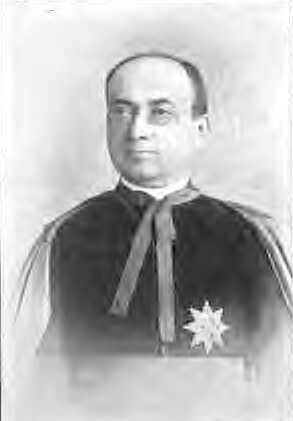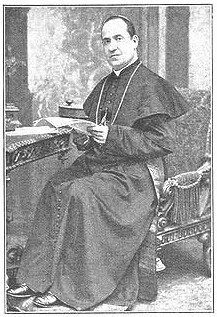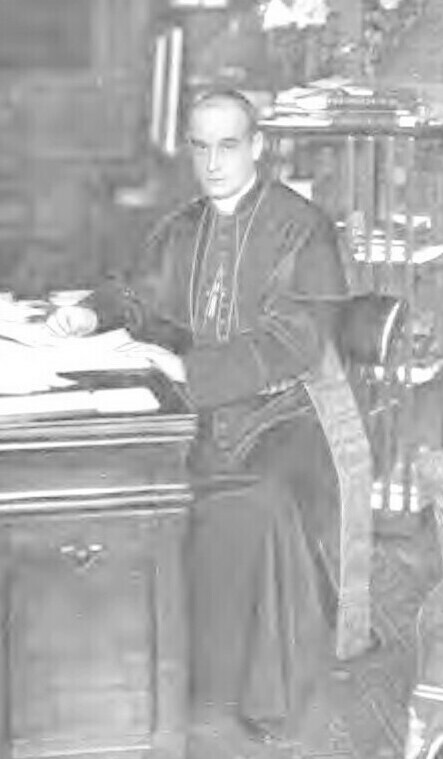SEDE VACANTE 1914
(August 20, 1914—September 3, 1914)
There were no coins.

Cardinal della Volpe
FRANCESCO SALESIO CARDINAL DELLA VOLPE (1844-1916) was essentially a member of the Papal Household for his early career, first as a Privy Chamberlain (1874), then Maestro di Camera (1886) and finally Majordomo (1891). He was named a Cardinal in 1899 as Cardinal Deacon of S. Maria in Aquiro; he became Cardinal Protodeacon in 1907. He served on a number of important Vatican Congregations, including Propaganda Fide (1903) and the Index (1911). He became Prefect of the Vatican Archives in 1908. On May 25, 1914, he was named Camerlengo of the Holy Roman Church, a post which he held until his death on November 5, 1916. He crowned Pope Benedict XV on September 6, 1914.

The Dean of the Sacred College of Cardinals was Cardinal Serafino Vannutelli (right). He was born at Gennazano near Palestrina in the Papal States in 1834. He studied in Rome at the Collegio Capranica and the Collegio Romano, obtaining doctorates in Philosophy and Theology. He subsequently obtained a doctorate in utroque iure. After some experience as a teacher at the Vatican seminary, he became an official in the Mexican Nunciature, during the reign of Maximilian I, Emperor of Mexico. He then served in the Nunciature in Munich. He was consecrated Archbishop of Nicaea in 1869 so that he could serve as Apostolic Delegate to the countries in Central America and northern and western South America. He was promoted to the Nunciature in Belgium in 1875, and then to Vienna in 1880.
For his services he was named a Cardinal by Pope Leo XIII in 1887, with the title of Santa Sabina. He opted for the title of S. Girolamo degli Schiavoni in 1889. He was named Archbishop of Bologna in January, 1893, but six months later opted for the Suburbicarian Bishopric of Frascati. Just before the death of Leo XIII he was promoted to the Diocese of Porto and Santa Rufina. In December, 1913 he was named Dean of the Sacred College of Cardinals, and the next May was installed as Bishop of Ostia. He served in the Roman Curia in several offices: he was Prefect of the S.C.of Indulgences and Sacred Relics (1888-1891), Prefect of the S.C. of the Index (1893-1896), Pro-Prefect of the S.C. of Bishops and Regulars (1896-1899), Major Penitentiary (1899-1915), Secretary of the S.C. of the Holy Office (1903-1908), and Prefect of the S.C. Ceremonial (1914-1915). He died in Rome on August 19, 1915.
Death of Pius X
Pius X had suffered a heart attack in 1913. In the Spring and Summer of 1914 he had been in a frantic state as the European political situation deteriorated into outright war. War was declared by Austria-Hungary against Serbia on August 1, and within days the First World War was in progress. On August 15 the Pope was taken seriously ill, with fever and lung complications. He died on August 20, 1914, possibly of influenza and pneumonia, though the immediate cause was a heart attack.
Cardinals and the War
At the time of the pope's death there were sixty-five cardinals. Pius had created fifty cardinals during his reign, and forty-five of them were still alive. He had created thirteen new cardinals less than three months earlier, on May 25, 1914, but the question was whether these or any cardinals would be able to assemble for a conclave, given the military and political situation. Amazingly, however, fifty-seven of the cardinals took part in the conclave. Cardinal Farley of New York attended, but three North Americans arrived too late. The two Hungarians were unable to attend, and two Italians and a Frenchman excused themselves on the grounds of ill health. One cardinal inside the conclave, Benedetto Lorenzelli (Lucca) was bedridden and unable to be in the Sistine Chapel for the opening ceremonies. The average age of those cardinals in attendance was 64.6.
- Serafino Vannutelli (aged 79), Bishop of Ostia and Porto e Santa Rufina, Dean of the Sacred College of Cardinals. Major Penitentiary (died August 19, 1915).
- Vincenzo Vannutelli (aged 77), Bishop of Palestrina. (died July 9, 1930). ex-Prefect of the Supreme Tribunal of the Apostolic Signature
- Antonio Agliardi (aged 81), Bishop of Albano . (died March 19, 1915). Chancellor of the Holy Roman Church
- Francesco de Paola Cassetta (aged 73), Bishop of Frascati (died March 23, 1919). ex-Prefect of the S.C. of the Council. Bibliothecarius S.R.E
- Gaetano de Lai (aged 61), Bishop of Sabina e Poggio Mirteto (died October 24, 1928). ex-Secretary of the S.C. Consistorial
- Diomede Falconio, OFM (aged 71), Bishop of Velletri (died February 8, 1917).
- Jose Sebastião Neto, OFM (aged 73), Cardinal-Priest of Ss. XII Apostoli (died December 7, 1920). former Patriarch of Lisbon.
- Angelo Di Pietro (aged 86), Cardinal Priest of S. Lorenzo in Lucina (died December 5, 1914). ex-Datary of His Holiness
- Michael Logue (aged 73), Cardinal Priest of S. Maria della Pace (died November 19, 1924). Archbishop of Armagh
- Andrea Ferrari (aged 64), Cardinal Priest of S. Anastasia (died February 2, 1921). Archbishop of Milan
- Girolamo Maria Gotti, OCD, Cardinal Priest of S. Maria della Scala (died March 19, 1916) ex-Prefect of the S.C. de propaganda Fide
- Domenico Ferrata (aged 67), Cardinal Priest of S. Prisca (died October 10, 1914). ex-Secretary of the Supreme S.C. of the Holy Office. Archpriest of the Lateran Basilica.
- José María Martín de Herrera y de la Iglesia (aged 79), Cardinal Priest of S. Maria in Traspontina (died December 8, 1922) Archbishop of Santiago de Compostela
- Giuseppe Francica Nava di Bontifé (aged 68), Cardinal Priest of Ss. Giovanni e Paolo (died December 7, 1928). Archbishop of Catania
- Agostino Richelmy (aged 63), Cardinal Priest of S. Maria in Via (died August 10, 1923). Archbishop of Turin, Italy
- Lev Skrbensky z Hriste (aged 51), Cardinal Priest of S. Stefano al Monte Celio (died December 24, 1938). Archbishop of Prague
- Giulio Boschi (aged 76), Cardinal Priest of S. Lorenzo in Panisperna (died May 15, 1920). Archbishop of Ferrara
- Bartolomeo Bacilieri (aged 72), Cardinal Priest of S. Bartolomeo all’Isola (died February 14, 1923). Bishop of Verona
- Rafael Merry del Val y Zulueta (aged 48), Cardinal Priest of S. Prassede (died February 26, 1930). ex-Secretary of State. Archpriest of the Vatican Basilica.
- Joaquim Arcoverde de Albuquerque Cavalcanti (aged 64), Cardinal Priest of Ss. Bonifacio ed Alessio (died April 18, 1930). Archbishop of Rio de Janeiro
- Aristide Cavallari (aged 65), Cardinal Priest of S. Maria in Cosmedin (died November 24, 1914). Patriarch of Venice
- Aristide Rinaldini (aged 70), Cardinal Priest of S. Pancrazio (died February 11, 1920).
- Benedetto Lorenzelli (aged 61), Cardinal Priest of S. Croce in Gerusalemme (died September 15, 1915). ex-Prefect of the S.C. of Studies
- Pietro Maffi (aged 55), Cardinal Priest of S. Crisogono (died March 17, 1931). Archbishop of Pisa
- Alessandro Lualdi (aged 56), Cardinal Priest of SS. Andrea e Gregorio al Monte Celio (died November 12, 1927). Archbishop of Palermo
- Desiré Mercier (aged 62), Cardinal Priest of S. Pietro in Vincoli (died January 23, 1926). Archbishop of Malines
- Pietro Gasparri (aged 62), Cardinal Priest of S. Bernardo alle Terme (died November 18, 1934).
- Louis-Henri Luçon (aged 71), Cardinal Priest of S. Maria Nuova (died May 28, 1930). Archbishop of Reims
- Paulin-Pierre Andrieu (aged 61), Cardinal Priest of S. Onofrio (died February 15, 1935). Archbishop of Bordeaux
- António Mendes Bello (aged 72), Cardinal Priest of Ss. Marcellino e Pietro (died August 5, 1929). Patriarch of Lisbon
- José María Cos y Macho (aged 75), Cardinal Priest of S. Maria del Popolo (died December 17, 1919). Archbishop of Valladolid
- Antonio Vico (aged 67), Cardinal-Priest of S. Callisto (died February 25, 1929). former diplomat in Colombia, Belgium and Spain.
- Gennaro Granito Pignatelli di Belmonte (aged 63), Cardinal Priest of S. Maria degli Angeli (died February 16, 1948).
- John Murphy Farley (aged 72), Cardinal Priest of S. Maria sopra Minerva (died September 17, 1918). Archbishop of New York
- Francis Bourne (aged 53), Cardinal Priest of S. Pudenziana (died January 1, 1935) Archbishop of Westminster
- Leon-Adolph Amette (aged 64), Cardinal Priest of S. Sabina (died August 29, 1920). Archbishop of Paris
- Enrique Almaraz y Santos (aged 66), Cardinal Priest of S. Pietro in Montorio (died January 22, 1922) Archbishop of Seville
- François-Marie-Anatole de Rovérié de Cabrières (aged 84), Cardinal Priest of S. Maria della Vittoria (died December 21, 1921). Bishop of Montpellier
- Basilio Pompilj (aged 56), Cardinal Priest of S. Maria in Ara Coeli (died May 5, 1931). Vicar-General of His Holiness for the City of Rome
- Károl Hörnig (aged 74), Cardinal Priest of S. Agnese fuori le mura (died February 9, 1917). Bishop of Veszprém
- Victoriano Guisasola y Menénedez (aged 62), Cardinal priest without titulus (died September 2, 1920). Archbishop of Toledo
- Domenico Serafini (aged 62), Cardinal Priest of S. Cecilia (died March 5, 1918).
- Giacomo della Chiesa (aged 59), Cardinal Priest of Ss. Quattro Coronati (died January 22, 1922). Archbishop of Bologna
- János Csernoch (aged 62), Cardinal Priest without titulus (died July 25, 1927). Archbishop of Esztergom
- Franz von Bettinger (aged 63), Cardinal Priest of S. Marcello (died April 12, 1917). Archbishop of München und Freising
- Hector-Irénée Sévin (aged 62), Cardinal Priest of Sma. Trinità al Monte Pincio (died May 4, 1916). Archbishop of Lyon
- Felix von Hartmann (aged 62), Cardinal Priest of S. Giovanni a Porta Latina (died November 11, 1919). Archbishop of Cologne
- Friedrich-Gustav Piffl, CCRSA (aged 49), Cardinal Priest without titulus (died April 21, 1932). Archbishop of Vienna
- Francesco Salesio della Volpe (aged 69), Cardinal Deacon of S. Maria in Aquiro (died November 5, 1916). Camerlengo of the Holy Roman Church
- Ottavio Cagiano de Azevedo (aged 68), Cardinal Deacon of Ss. Cosma e Damiano (died July 11, 1927). ex-Prefect of the S.C. of Religious
- Gaetano Bisleti (aged 58), Cardinal Deacon of S. Agata de’ Goti (died August 30, 1937).
- Louis Billot, SJ (aged 68), Cardinal Deacon of S. Maria in Via Lata (died December 18, 1931).
- Willem Marinus van Rossum, CSSR (aged 60), Cardinal Deacon of S. Cesareo in Palatio (died August 30, 1932). President of the Pontifical Commission for Biblical Studies
- Scipione Tecchi (aged 60), Cardinal Deacon of S. Maria in Domnica (died January 22, 1915).
- Filippo Giustini (aged 62), Cardinal Deacon of S. Angelo in Pescheria (died March 17, 1920). ex-Secretary, SC Sacraments.
- Michele Lega (aged 54), Cardinal Deacon of S. Eustachio (died December 16, 1935).
- Francis Aidan Gasquet, OSB (aged 67), Cardinal Deacon of S. Giorgio in Velabro (died April 5, 1929). President, Pontifical Commission for the Revision and Emendation of the Vulgate.
- James Gibbons (aged 91), Cardinal-Priest of S. Maria in Trastevere (died March 24, 1921). Archbishop of Baltimore.
- Kolos Ferenc Vaszary, OSB (aged 82), Cardinal Priest of Ss. Silvestro e Martino ai Monti (died September 3, 1915). Archbishop of Esztergom
- Giuseppe Prisco (aged 80), Cardinal Priest of S. Sisto (died February 4, 1923). Archbishop of Naples
- Sebastiano Martinelli, OESA (aged 66), Cardinal Priest of S. Agostino (died July 4, 1918) ex-Prefect of the S.C. of Rites
- Franziskus Bauer (aged 73), Cardinal Priest of S. Girolamo dei Croati (died November 25, 1915). Archbishop of Olomouc
- William Henry O'Connell (aged 54), Cardinal Priest of S. Clemente (died April 22, 1944). Archbishop of Boston
- François Virgile Dubillard (aged 69), Cardinal Priest of S. Susanna (died December 1, 1914). Archbishop of Chambéry
- Louis-Nazaire Bégin (aged 74), Cardinal Priest of Ss. Vitale, Valeria, Gervasio e Protasio (died July 19, 1925). Archbishop of Québec

The assembly of fifty-seven cardinals was all the more amazing seeing that Pius and his Secretary of State, Rafael Merry del Val (right), had offended most of the governments of Europe in one way or another through their rigorous instance on the rights of the Church. The Papacy had denounced the separation of church and state, both in France and Portugal. And in Italy, the Papacy, it should be remembered, had never come to terms with the unification of Italy; the Italian State was still the enemy. But, with the rise of socialism, Pius had permitted Italians to vote in democratic elections, but only if it was to avoid some socialistic take-over. When Socialists actually did rise to power in Berlin in 1918, and the Communists attempted to overthrow the government of Bavaria, the policy became more intense and more rigid. This fear became the leit-motif of papal politics for the rest of the century, featuring fear of Communism and the domination of atheistic Russia. Such alternatives as Fascism, Nazism and the Falange were entities that an autocratic Church would have a much more comfortable time doing business with.
Balloting
The conclave opened on August 31, 1914, with the Mass of the Holy Spirit being celebrated in the Pauline Chapel by Cardinal Domencio Ferrata (Secretary of the Holy Office). The cardinals were divided into two factions, the 'Integrationists' (reactionaries) and the 'Progressives' (conservatives). Pius X's decade-long campaign against "Modernism" ensured that there were fewer moderates than one might have expected. In addition, there was a fear that one of the sides in the World War (England-France and Germany-Austria) might attempt to influence the Conclave to elect a pope who would be favorable to their side in the conflict. The Conclave was therefore filled with more than usual suspicion.
In the first ballot, Cardinal Pietro Maffi (Pisa) had 12 votes, as did Cardinal Giacomo della Chiesa (Bologna). From the factional point of view, there were 22 votes for integrationist candidates, and 32 for progressives. (It should be remembered that the 'accessio' had been abandoned by the cardinals in 1903). In the third scrutiny, Della Chiesa had 18 votes and Maffi had 16. In the fourth scrutiny, Della Chiesa rose to 21, and Maffi had dropped to 14.
On September 2, in the fifth scrutiny, Della Chiesa lost one vote, but in the sixth scrutiny, he advanced to 27 votes. In the seventh scrutiny he moved up to 31, and in the eighth, he had 32; Domenico Serafini, OSB (a curial cardinal, only appointed on May 25, who had once been Apostolic Delegate in Mexico) had 24; and Agostino Richelmy (Turin) one. Della Chiesa had a majority, but not a two-thirds majority, and Serafini's integrationists had enough votes to ensure that he never got it. The Conclave faced a potential deadlock.
Election
Next day, September 3, in the ninth scrutiny, Della Chiesa advanced again, to 34 votes, and Serafini had 22. Richelmy still had one. In the tenth scrutiny, on the morning of September 3, 1914, Della Chiesa had 38 votes (an exact 2/3 majority), Domenico Serafini had 18, and Agostino Richelmy one. Giacomo della Chiesa took the name Benedict XV. The examination of Della Chiesa's ballot was demanded, to ensure that he had not given himself the vote that gave him the two-thirds majority. This was a gratuitous insult, implying that Della Chiesa was not above violating the regulations of the Conclave.
Benedict XV immediately replaced the Secretary of State of Pius X, Rafael Merry del Val (an arch-conservative), with Domenico Ferrata (former Nuncio in Paris) and, when he died in October, with Pietro Gasparri. The anti-Modernist reign of terror was beginning to abate.
Benedict XV was crowned at the Vatican on September 6, 1914 by Cardinal Francesco della Volpe, the Cardinal Proto-Deacon. Being one of the self-styled "prisoners of the Vatican", he never took possession of his Cathedral Church, San Giovanni Laterano.
Bibliography
"Sergius", Le pape d' hier, le pape d'aujourd'hui: Benoit XV Pie IX (Paris 1922), chapitre III, "Le conclave de 1914", pp. 25-30. H.E.G. Rope, Benedict XV: The Pope of Peace (Catholic Book Club 1941). John F. Pollard, Benedict XV: The Unknown Pope and the Pursuit of Peace (New York: Continuum International Publishing Group 1999). Francis A. Burkle-Young, Papal Elections in the Age of Transition, 1878-1922 (Lanham MD: Lexington Books 2000). Francis A. Burkle-Young, Passing the Keys: Modern Cardinals, Conclaves, and the Election of the Next Pope (Lanham MD: Madison Books 1999) 11-16.